Top Image: Jewels and other items are on display during the court martial of Colonel Jack. W. Durant in Frankfurt, Germany. Image courtesy of the National Archives.
By early 1946, Princess Sophia von Hessen, widow of Prince Christoph, was preparing to remarry. Her mother-in-law, Princess Margarethe von Hessen, had already attempted to retrieve from US Army personnel the box of jewels hidden in the cellar of the family home. Her attempts had been rebuffed by WAC Captain Kathleen Nash, and in April, Sophia finally managed to convince the US Army CID (Criminal Investigation Division) to launch an investigation. Sophia was convinced the jewels had been stolen.
Princess Sophia was correct, and it did not take long for the investigation to land on Captain Nash, Colonel Jack Durant, and Major David Watson. The three had stolen the jewels, broken many up, and begun selling them off, confident that they were getting away with it. By April, when Sophie went to the CID, Nash and Durant had already returned to the United States, but Watson was still in Frankfurt, so the investigators had an easy time keeping track of him.
Back in the United States, Durant was on leave on the East Coast, trying to either sell or hide everything he had brought back. It was difficult to sell gems without paperwork, but Durant managed to unload several large ones, using a fake name at times. He even used a diamond to help buy a car. Nash, on terminal leave (leave taken before discharge from the military) prior to her discharge, was out in California, but traveled to Chicago in March to meet up with Durant. There, they tried to sell more gems, but the jeweler refused as none of the gems had the required customs documents. The jeweler called the police, providing an important tip to investigators. From there, the situation began to decline quickly for Nash and Durant.
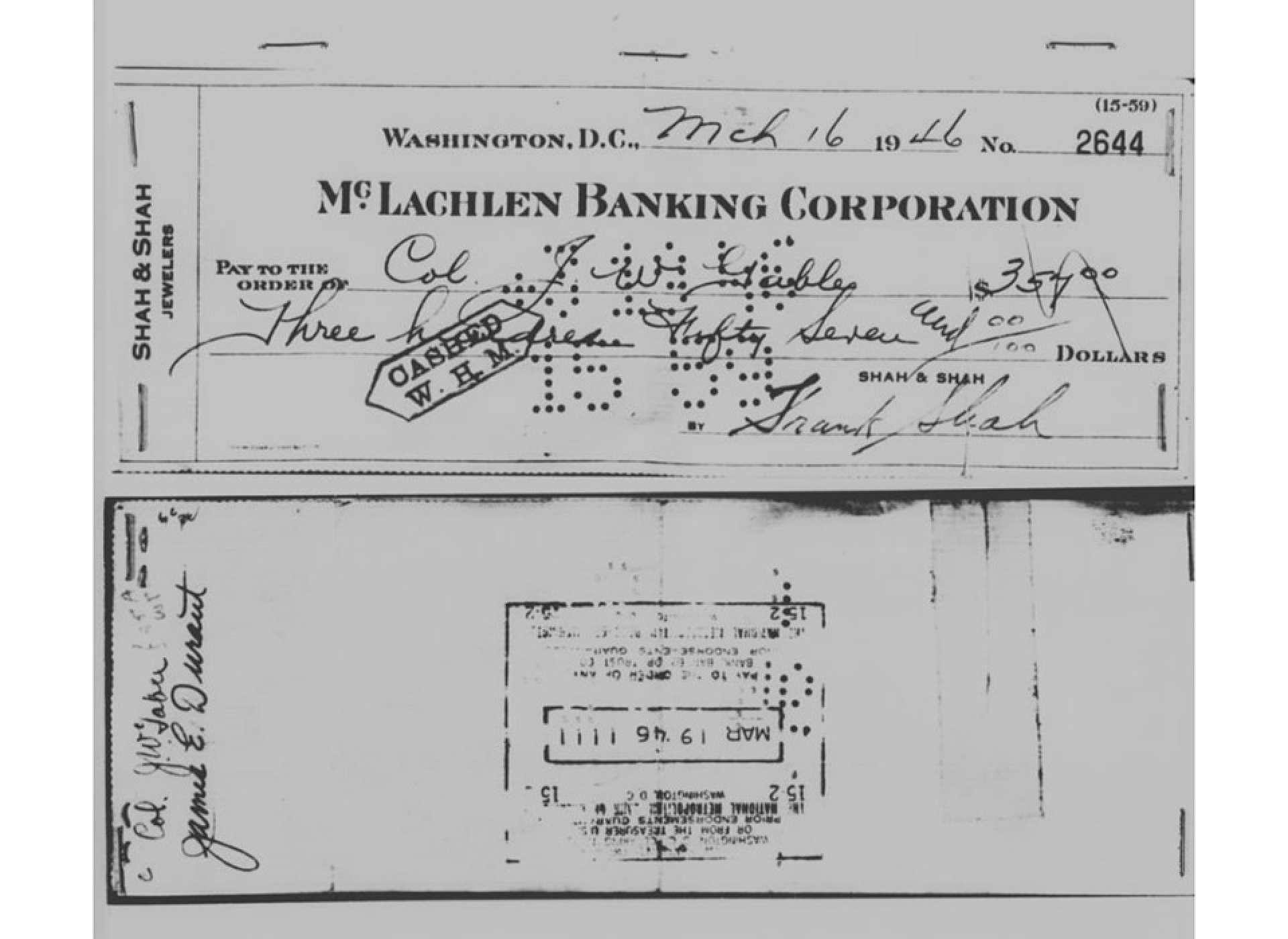
This check, bearing a false name used by Durant—Col. J.W. Gables—was entered as evidence in Durant’s court martial. Image courtesy of the National Archives.
A customs agent contacted Durant, who was forced to surrender 102 loose diamonds he had not declared upon returning to the United States. Durant then forged paperwork which claimed he was being separated from active duty. When Durant visited his former secretary to pick up more stolen items which she had brought back for him, she asked him if he was concerned about getting into trouble over the stolen goods. Durant replied, “Get into trouble? I’m already up to my neck in it now.”
Although Durant was feeling the heat, he and Nash occasionally flaunted their loot. Dining with friends in Chicago, Nash wore a platinum watch with 606 diamonds that had belonged to Mafalda. At that time, it was valued at $7,500, today that amount would be $110,000. In addition to selling jewels, Durant had his brother help him bury loose stones in jars in numerous locations in Virginia.
On May 28, 1946, Nash and Durant married. The motive behind their nuptials can be questioned. They had not known each other for very long, and Durant had been seeing other women. But Durant had been a lawyer before joining the US Army Air Forces, and no doubt knew that were they caught and tried, neither could be forced to testify against the other if they were married. They also had reason to believe their situation was in jeopardy. Four days before their marriage, Nash’s terminal leave was canceled. On May 29, she received a telegram ordering her to report to Fort Sheridan, Illinois. A couple of days later, Durant received notice that his leave was cancelled, and he was to report to the same location. The possibility of a coincidence was too slim.
Nash and Durant chose to ignore the orders and visited her sister in Wisconsin before traveling to Chicago. There, they checked into the luxurious La Salle hotel on June 2. After depositing their luggage in their room and changing, Nash and Durant left for the evening, unaware that CID men would be waiting for them in the room next door. At two in the morning, the pair returned to their room and ordered champagne. As they were filling their glasses there was a knock on the door, a CID arrest team was moving in. It was over. Nash was immediately taken into custody and subjected to a polygraph test. When asked about taking jewels from Kronberg Castle, Nash “failed” the test. Durant was taken into custody the following day, though he was not held.
Meanwhile, investigators interviewed Nash and Durant’s families, searched their homes, and the home of Nash’s former assistant. A fair amount of the stolen goods was found, and Durant directed them to more via one of the individuals who had purchased gems from him. Once officially charged with the theft, Nash and Durant were flown back to Germany, where Watson was in custody and their trials would take place. As the theft had taken place in Germany, they were each tried independently in courts martial in Frankfurt. The publicity surrounding the trials was so hot that tickets were printed for civilians who wished to witness the trials.
The first to be tried was Nash. Her trial began in late August 1946 and lasted just over a month. Nash was charged with being absent without leave, larceny, fraud against the government, conduct unbecoming of an officer and a gentleman, and bringing discredit upon military service. Wearing a uniform stripped of insignia, Nash appeared in court and refused to enter a plea.
Her lawyer argued that since she had been put on terminal leave, the Army no longer had jurisdiction over her. He further argued that the family had abandoned the items, therefore making them fair game to be taken by Allied personnel. They were, he declared, legitimate spoils of war. The extensive trial included witness testimony by Princesses Sophie and Margarethe, as well as the estate manager Heinrich Lange, and other members of the Hessen family. The stolen items which had been recovered were laid out in a grand exhibition, illustrating the enormity of what had been taken. The list of items Nash was accused of stealing was nearly four pages long.
-

One of four pages which inventoried the items Nash was charged with stealing. From the official court martial proceedings against Nash. The full record of the Hesse heist courts martial, numbering more than 12,000 pages, is available from the National Archives. Image courtesy of the National Archives.
-

Sorted into a velvet lined box are gemstones recovered in the case against Nash, Durant, and Watson. Here they are on display as evidence in Nash’s court martial in Frankfurt. The recovered jewels were guarded by members of the 709th Military Police Battalion. Image courtesy of the National Archives.
At the end of the trial, despite her lawyers’ efforts to claim she shouldn’t be tried for what others had done—taking enemy loot, Nash was found guilty of being absent without leave and of the theft of the jewels. She was discharged from military service and sentenced to serve five years in a federal prison. The extensive record of Nash’s trial, which is now in the US National Archives, numbers almost 2,000 pages.
Watson was tried next, and his trial was brief, lasting only two weeks. He was found not guilty of larceny of the Hessen family jewels, on the basis that Nash and Durant had been the ones to actually steal the items. Watson was found guilty of bringing discredit to military service by giving away or selling items stolen from the castle. He was dismissed from service and confined to hard labor for three years. Nash and Watson were tried first, with the hopes that if found guilty, Durant’s case might be made easier.
Durant’s court martial began in Frankfurt in December 1946 and lasted until April 1947. Nash was brought in to testify, but as the two were married she had to consent to do so. When asked if she consented, Nash said no, and was removed from the witness stand. Durant’s brother, sister-in-law, and an old girlfriend were called in to testify. The three refused to fly to Germany, not wishing to participate in the trial, and could not be forced to travel. Instead, proceedings were temporarily relocated to Washington, DC, to compel them into participating.
The girlfriend cooperated, but Durant’s brother and his wife refused to cooperate. On the stand, each responded, “I decline to answer” when asked a question. Jewelers from various cities in both the United States and Europe testified against Durant. Once again, items stolen from the family were laid out as evidence. Also entered into evidence were numerous photos of the Princesses von Hessen, shown wearing the intact pieces which Durant and his co-conspirators had broken apart. At the trial’s conclusion, Durant was found guilty. Considered by most to be the ringleader of the whole ordeal, Durant received the most severe punishment—dismissed from service and 15 years of hard labor.
-

Recovered jewels and other items on display at the Pentagon in Washington, DC. Image courtesy of the National Archives.
-

This photograph of Princess Sophia von Hesse wearing a tiara, necklace, earrings, and bracelet of emeralds and diamonds was entered into evidence in the court martial of Durant. The emerald and diamond set was originally given to Sophia’s mother-in-law, Princess Margarethe, upon her marriage to Prince Frederick, the Landgrave of Hesse. One of the many priceless pieces broken up, only a few of the emeralds were recovered. Image courtesy of the National Archives.
After their trials, each of the conspirators, now guilty and in prison, began their appeals. Almost as soon as she was incarcerated, Nash began an appeal of her case. She did not try to plead innocence but continued to fight her strong belief that the Army no longer had jurisdiction over her at the time of her arrest. A district court agreed, and Nash was let go. However, the government appealed, and the original ruling was upheld. Nash had to return to prison in 1948 and serve out the remainder of her sentence.
Watson began a campaign to get clemency. He collected 275 letters of support, his case was reviewed, and he was paroled in December 1947. He then turned his efforts to obtaining a presidential pardon, which he received from then-President Eisenhower in 1957. Durant likewise challenged his conviction but was unsuccessful in his appeals. He remained in prison until 1952. During that time, he and Nash divorced, though they reunited after his release and lived together until their deaths in the 1980s.
Nash, Durant, and Watson had all tried desperately to make the claim that they were just doing what thousands of other GIs had done—take “war loot.” They justified taking jewels and other items from the von Hessen family due to the family’s ties to the Nazi Party, and that they had “abandoned” them. The courts upheld the ruling that just because everyone else was doing it, didn’t mean it wasn’t against the law. In the end, it was theft, plain and simple. Stealing tiaras from princesses was not the same as taking a mattress out of an abandoned building or picking up Luger pistols on the battlefield.
As for the jewels, in the end an estimated $2.5 million worth of jewels and other items had been stolen. That is equivalent to around $36 million today. Some stones that were buried by Durant and his brother were allegedly never found, though his brother, who lived a very financially modest life, left a rather sizable estate. Despite numerous pleas from, and on behalf of, the Hessen family, the surviving items weren’t returned until 1951. It was estimated that less than half were recovered, and since so many had been dismantled, the whole collection was estimated to be worth only a tenth of its previous value. Some items did survive intact, like the wheat tiara Mafalda wore at her wedding. Younger generations of Hessen brides continue to wear the surviving pieces, or new pieces fashioned from the stones.
It is unlikely that any of the jewels or pieces yet unrecovered will ever surface. Once taken out of an identifiable setting, most gems are almost impossible to trace. But the possibility of return remains. In 2015, two paintings were returned to the von Hessen family by the Monuments Men Foundation.
-

Donatus Landgraf von Hessen (left) and Monuments Men Founder and Chairman Robert M. Edsel pose with two paintings which the Foundation returned to the von Hessen family after they were taken from Kronberg Castle 70 years prior. The National WWII Museum, Monuments Men Foundation Collection.
-

The top painting is Charles I in Three Positions, the bottom is Madonna and Child, which depicts Queen Victoria and her eldest daughter, Victoria, who married Friedrich, the son of Kaiser Wilhelm I. Victoria brought both with her when she married Friedrich. The National WWII Museum, Monuments Men Foundation Collection.
Taken from the castle during the war, the two paintings were purchased by a woman serving as a librarian with the US Special Services after the war. In 2014, the Foundation received several tips regarding the paintings, and upon investigation, it was confirmed the two paintings had belonged to the von Hessen family—the current Landgraf von Hessen still had the inventories which listed each one! The paintings were Madonna and Child, which featured Queen Victoria and her daughter, the future Empress Victoria, and Charles I in Three Positions, both paintings brought to Germany by Empress Victoria. Returned 70 years after they were taken, could the paintings hold hope that some of the von Hessen jewels might surface once again?
Kali Martin
Kali Martin is a former Research Historian of The National WWII Museum's Jenny Craig Institute for the Study of War and Democracy.
Cite this article:
MLA Citation:
APA Citation:
Chicago Style Citation:
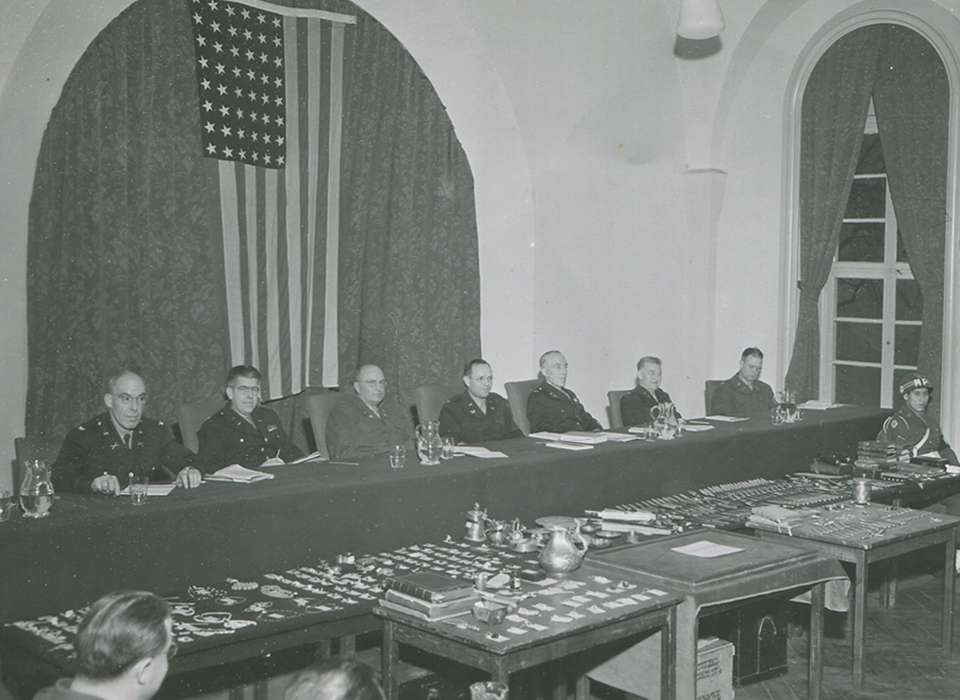
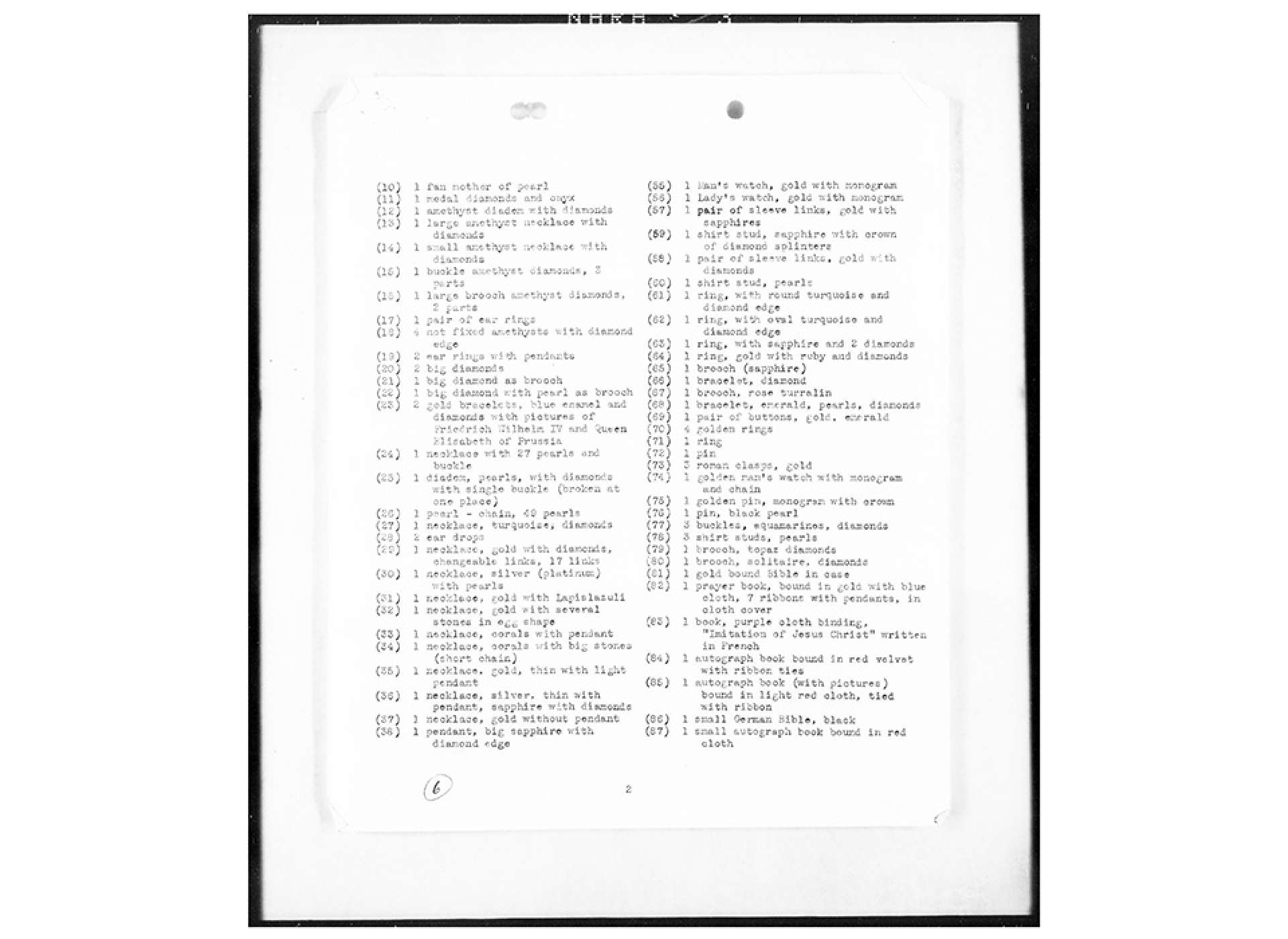
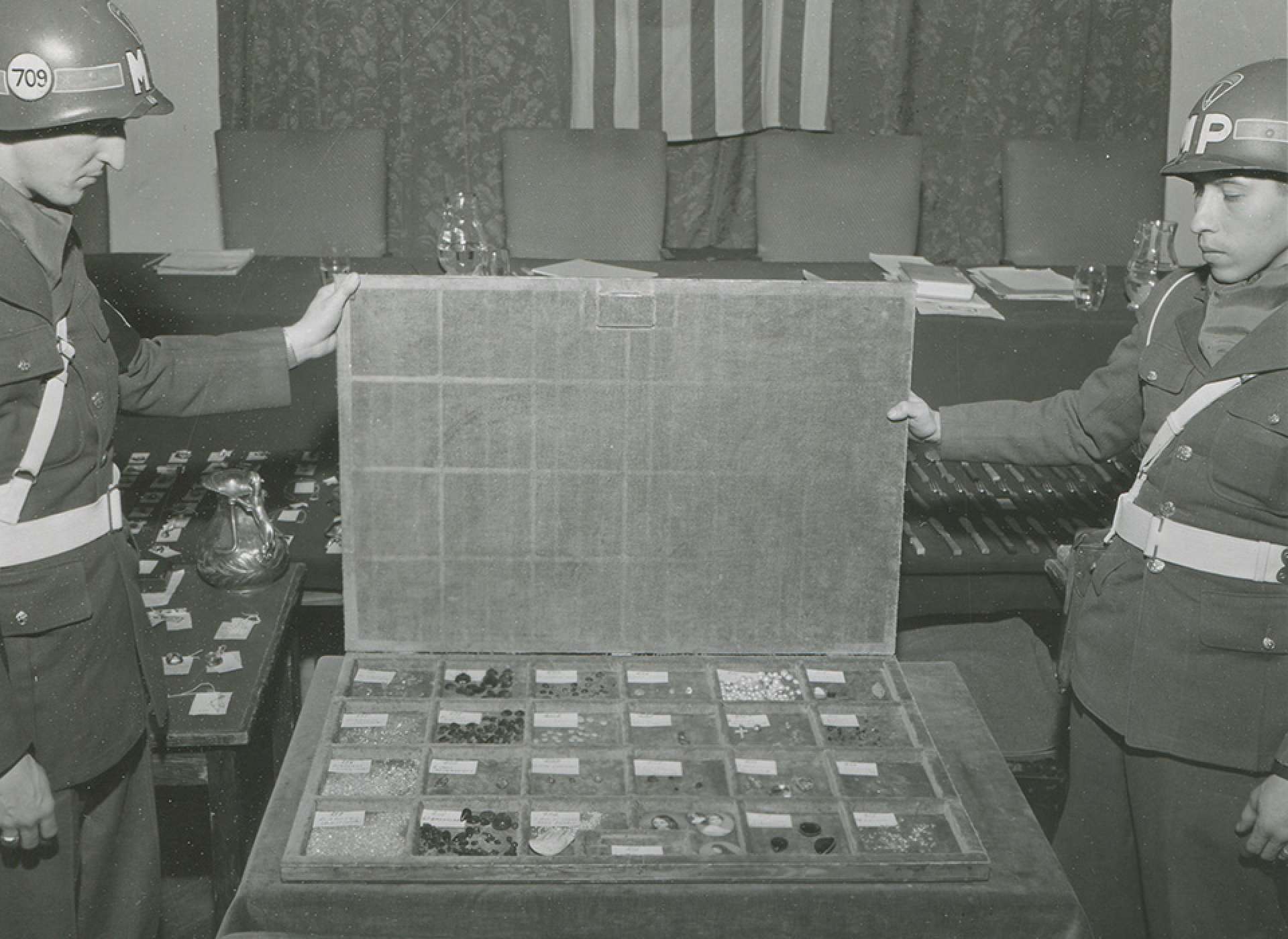
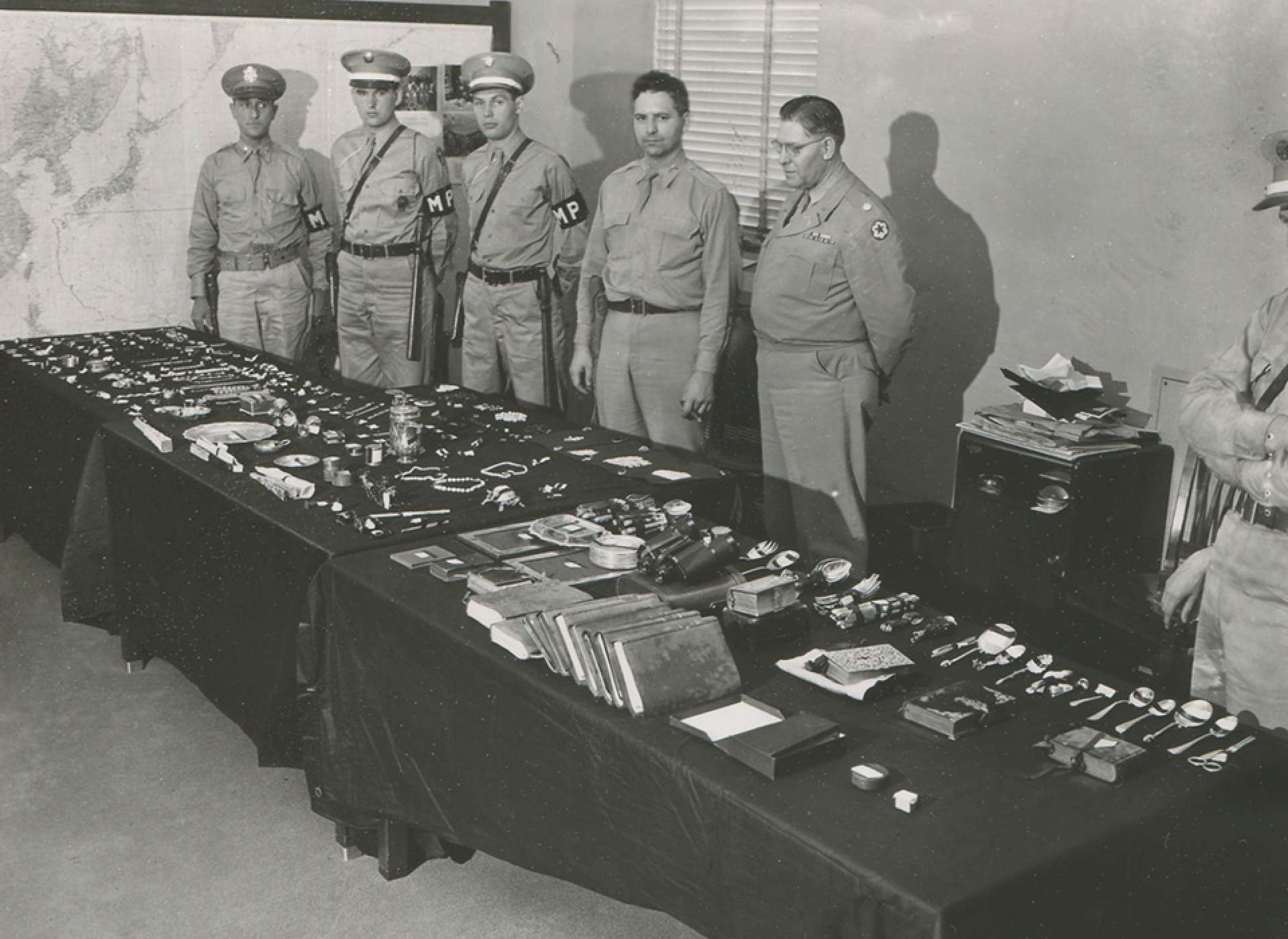
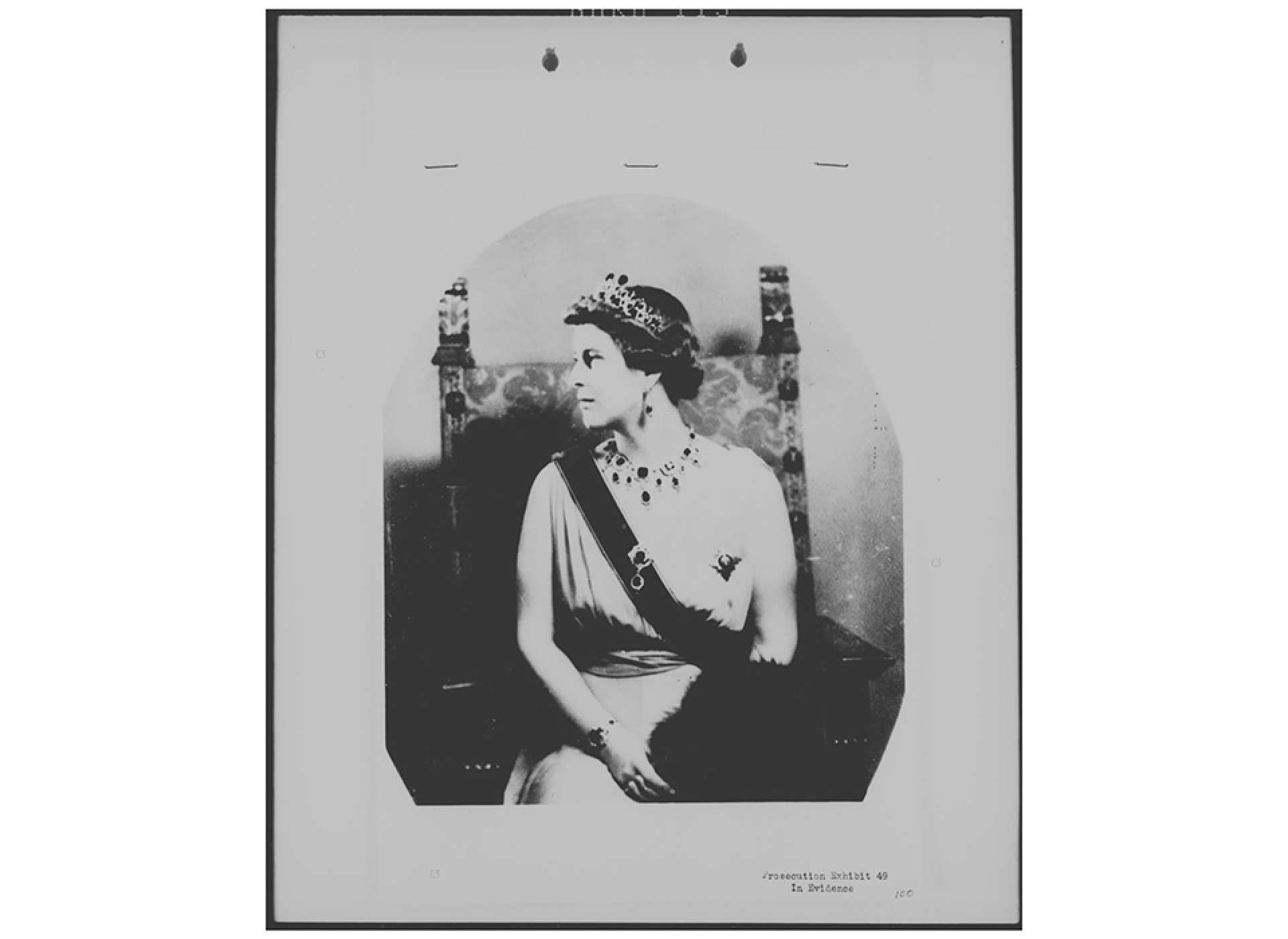
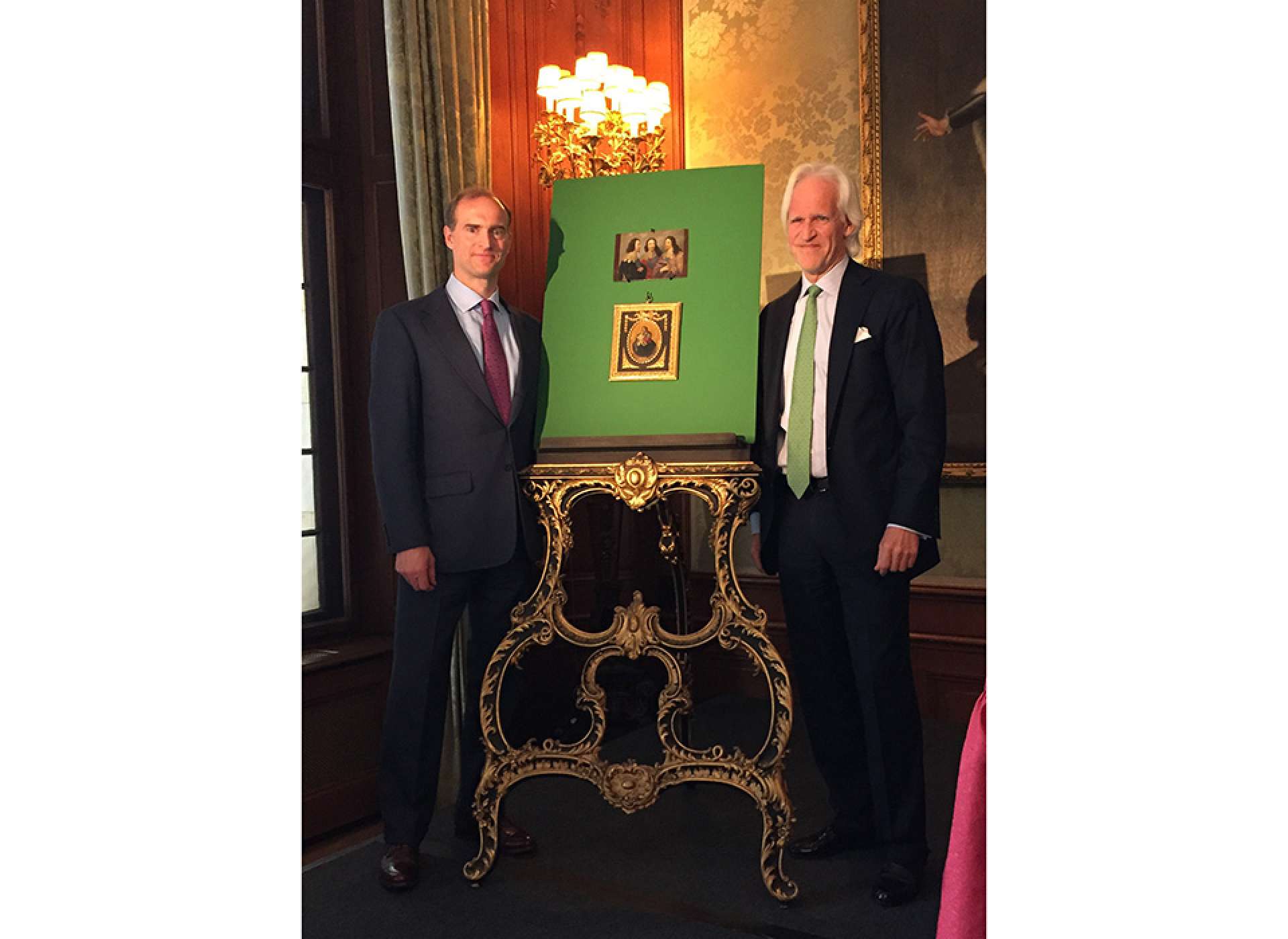
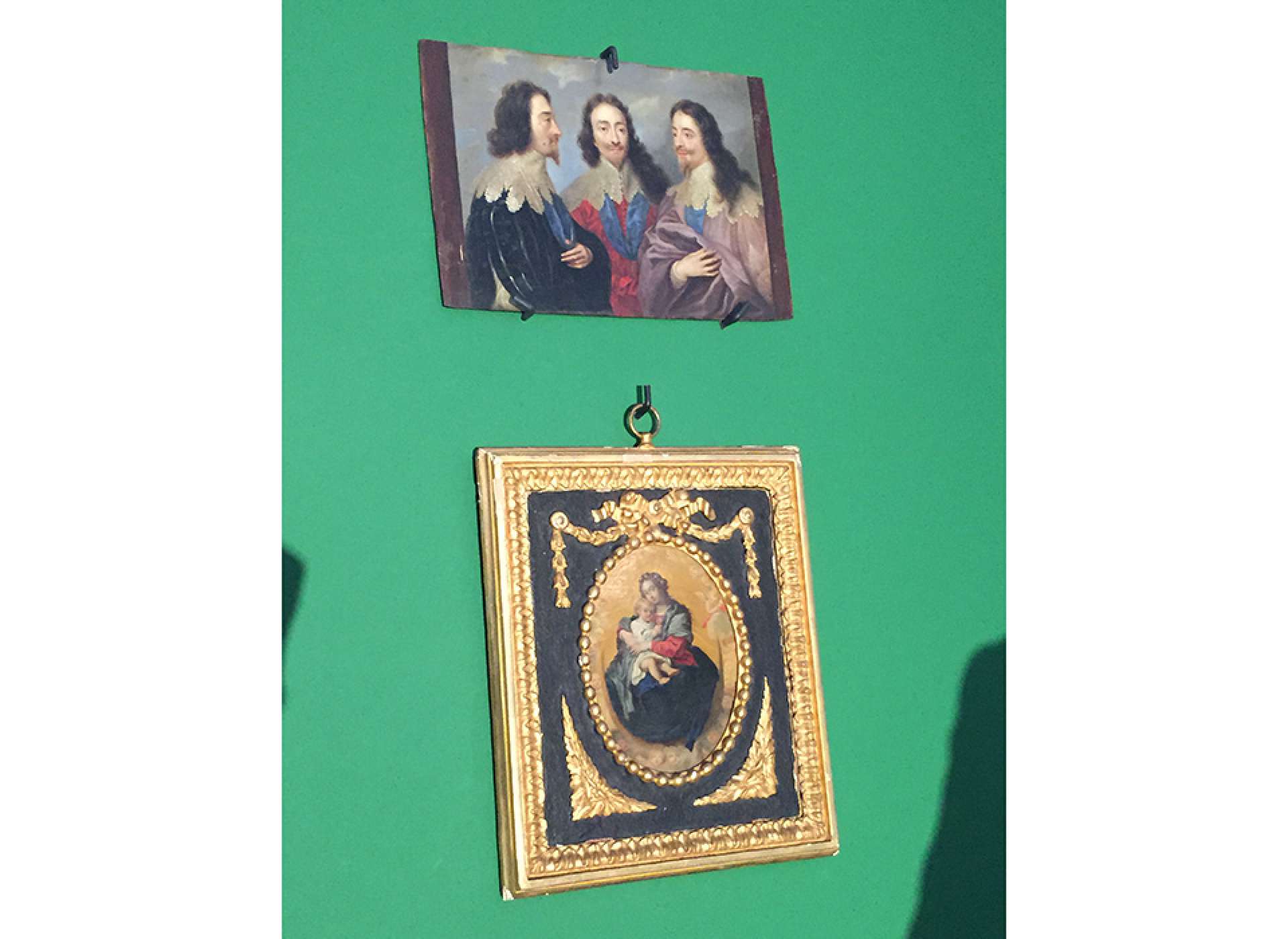

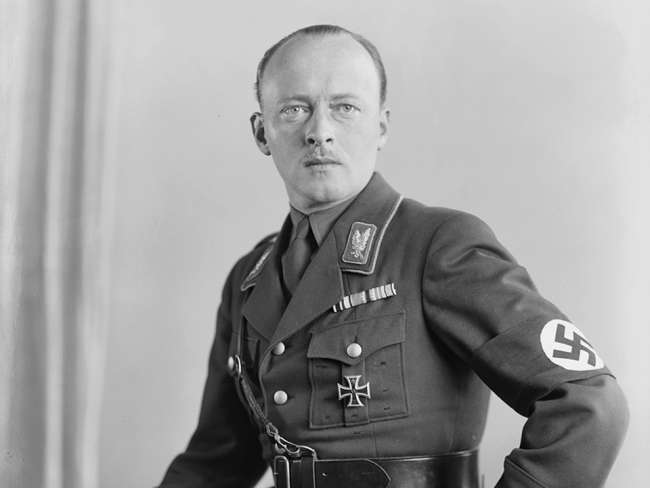
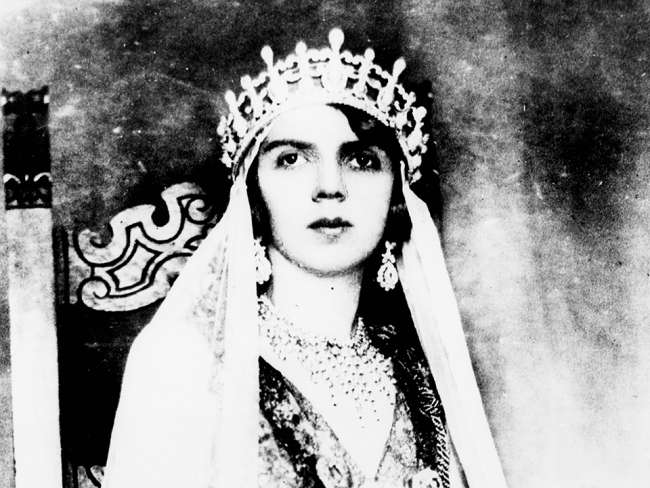
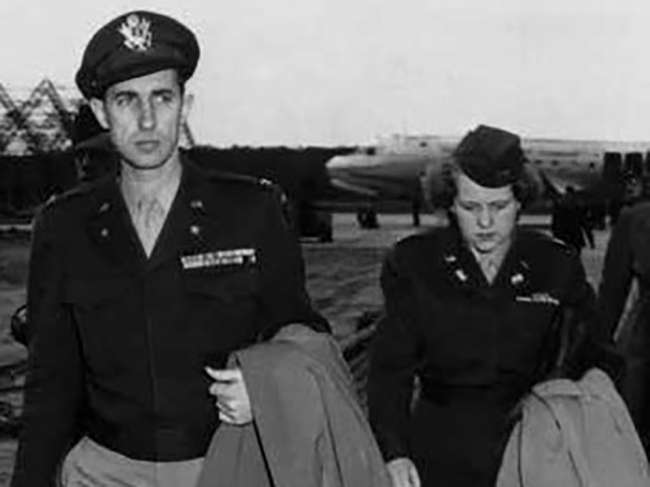



![Max Fuchs, New York City cantor, sings as Rabbi Sydney [sic] Lefkowitz, Richmond, VA, conducts the first Jewish services from Germany.](/sites/default/files/styles/max_650x650/public/2025-10/image1.jpg)



